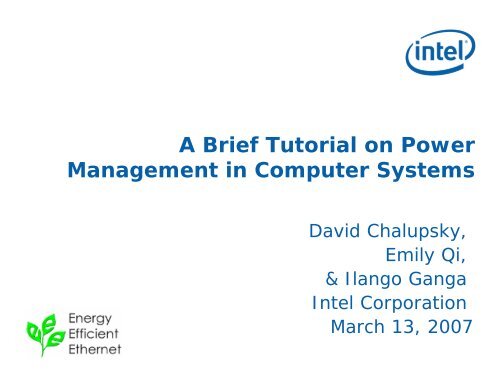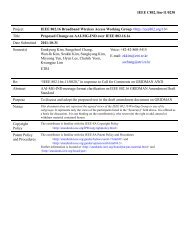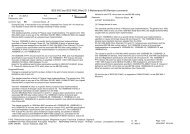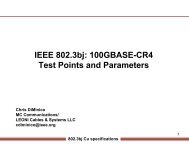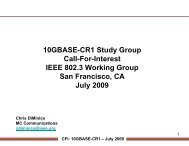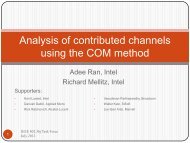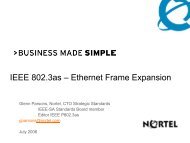A Brief Tutorial on Power Management in Computer Systems
A Brief Tutorial on Power Management in Computer Systems
A Brief Tutorial on Power Management in Computer Systems
You also want an ePaper? Increase the reach of your titles
YUMPU automatically turns print PDFs into web optimized ePapers that Google loves.
A <str<strong>on</strong>g>Brief</str<strong>on</strong>g> <str<strong>on</strong>g>Tutorial</str<strong>on</strong>g> <strong>on</strong> <strong>Power</strong><br />
<strong>Management</strong> <strong>in</strong> <strong>Computer</strong> <strong>Systems</strong><br />
David Chalupsky,<br />
Emily Qi,<br />
& Ilango Ganga<br />
Intel Corporati<strong>on</strong><br />
March 13, 2007
2<br />
Objective & Agenda<br />
Objective:<br />
• Establish a comm<strong>on</strong> foundati<strong>on</strong> for EEESG work by provid<strong>in</strong>g<br />
an overview and history of PC power management and LAN<br />
use <strong>in</strong> that c<strong>on</strong>text.<br />
Agenda:<br />
• High Level overview of PC power management<br />
– L<strong>in</strong>ks to additi<strong>on</strong>al <strong>in</strong>formati<strong>on</strong><br />
• How Ethernet is utilized <strong>in</strong> C<strong>on</strong>temporary PC <strong>Power</strong><br />
<strong>Management</strong><br />
• Mak<strong>in</strong>g <strong>Power</strong> <strong>Management</strong> and Ethernet more effective<br />
<strong>in</strong> the future<br />
March 11, 2007 File: chalupsky_01_0307
3<br />
PC <strong>Power</strong> States circa 1990<br />
• ON<br />
• OFF<br />
Sounds nice & simple. What’s wr<strong>on</strong>g with that?<br />
• Time to boot the PC from a cold start took too l<strong>on</strong>g, and<br />
got l<strong>on</strong>ger as PCs became more complex.<br />
• As a result, people left their PCs <strong>on</strong> all the time, wast<strong>in</strong>g<br />
energy.<br />
March 11, 2007 File: chalupsky_01_0307
Historical (1990’s) Motivati<strong>on</strong> for <strong>Power</strong> <strong>Management</strong><br />
by market segment<br />
Laptops & Battery <strong>Power</strong>ed Devices<br />
– Battery Life is a key product feature, thus<br />
– Commercial <strong>in</strong>centive has always been there<br />
– Vendor-specific soluti<strong>on</strong>s preceded standards<br />
Desktop PCs<br />
– Little end user benefit perceived for PM.<br />
– Initial attenti<strong>on</strong> to PM <strong>in</strong> 1992 with the release of EPA’s<br />
Energy Star program and <strong>in</strong>ternati<strong>on</strong>al counterparts.<br />
Server <strong>Systems</strong><br />
– Historically, a very performance oriented segment<br />
– Always <strong>on</strong> & ready for maximum performance<br />
– Recent, market-driven, attenti<strong>on</strong> to power due to high cost of<br />
electricity & cool<strong>in</strong>g <strong>in</strong> Data Centers<br />
– EPA just beg<strong>in</strong>n<strong>in</strong>g to focus <strong>on</strong> Servers <strong>in</strong> 2006/2007<br />
4<br />
March 11, 2007 File: chalupsky_01_0307
5<br />
Enter the Sleep State – 1990’s<br />
To reduce PC energy c<strong>on</strong>sumpti<strong>on</strong> dur<strong>in</strong>g periods of <strong>in</strong>activity, the<br />
<strong>in</strong>dustry <strong>in</strong>troduced the c<strong>on</strong>cept sleep, or standby, states.<br />
Goals<br />
• <strong>Power</strong> c<strong>on</strong>sumpti<strong>on</strong> at near Off levels<br />
• Quick recovery to active state<br />
Wak<strong>in</strong>g the System<br />
• Return to active state based up<strong>on</strong> user <strong>in</strong>put<br />
• Keyboard, Mouse, <strong>Power</strong> Butt<strong>on</strong><br />
March 11, 2007 File: chalupsky_01_0307
6<br />
Enter Wake On LAN<br />
In corporate envir<strong>on</strong>ments, PCs were STILL be<strong>in</strong>g left<br />
<strong>on</strong> all night.<br />
• <strong>Systems</strong> backups, remote management and upgrades<br />
performed at night, over the LAN.<br />
• IT needed system availability.<br />
• Wake On LAN (WOL) allowed system to sleep at night<br />
and be turned <strong>on</strong> remotely for management.<br />
• First products appeared ~1996.<br />
March 11, 2007 File: chalupsky_01_0307
7<br />
<strong>Power</strong> <strong>Management</strong> Standards<br />
For multi-vendor <strong>in</strong>teroperability, standards were required<br />
• Initial effort: APM<br />
– Advanced <strong>Power</strong> <strong>Management</strong><br />
– Early-mid 1990’s<br />
• Current: ACPI<br />
– Advanced C<strong>on</strong>figurati<strong>on</strong> and <strong>Power</strong> Interface<br />
– 1996 – present<br />
– ACPI is still evolv<strong>in</strong>g to comprehend new system capabilities<br />
– Coord<strong>in</strong>ated with support<strong>in</strong>g <strong>in</strong>terface specificati<strong>on</strong>s:<br />
• PCI <strong>Power</strong> <strong>Management</strong>, USB, Cardbus, PCI Express, etc.<br />
– Coord<strong>in</strong>ated with support<strong>in</strong>g Device Class specificati<strong>on</strong>s:<br />
• Network, Storage, Graphics, etc.<br />
March 11, 2007 File: chalupsky_01_0307
Advanced <strong>Power</strong> <strong>Management</strong> (APM)<br />
The Legacy Method<br />
• BIOS-based system power management<br />
– Operat<strong>in</strong>g System has no knowledge of what APM does<br />
• Provides CPU and device power management<br />
• Invoked when idle - provides CPU power mgt.<br />
• Uses device activity timeouts to determ<strong>in</strong>e when to transiti<strong>on</strong><br />
devices <strong>in</strong>to low power states<br />
• Each system board vendor must ref<strong>in</strong>e and ma<strong>in</strong>ta<strong>in</strong> APM<br />
BIOS code/IP<br />
• Wide variety of implementati<strong>on</strong>s and functi<strong>on</strong>ality<br />
– No uniform user experience<br />
• Primitive Wake On LAN support<br />
8<br />
March 11, 2007 File: chalupsky_01_0307
ACPI<br />
9<br />
Advanced C<strong>on</strong>figurati<strong>on</strong> and <strong>Power</strong> Interface<br />
An “<strong>in</strong>terface” specificati<strong>on</strong><br />
Allows OS-directed <strong>Power</strong> <strong>Management</strong> (OSPM)<br />
• ACPI/OSPM replaces APM, MPS, and PnP BIOS Spec<br />
• PM awareness is global <strong>in</strong> the system, not hidden like <strong>in</strong> APM.<br />
Def<strong>in</strong>es<br />
• Hardware registers - implemented <strong>in</strong> chipset silic<strong>on</strong><br />
• BIOS <strong>in</strong>terfaces<br />
– C<strong>on</strong>figurati<strong>on</strong> tables<br />
– Interpreted executable functi<strong>on</strong> <strong>in</strong>terface (C<strong>on</strong>trol Methods)<br />
– Motherboard device enumerati<strong>on</strong> and c<strong>on</strong>figurati<strong>on</strong><br />
• System and device power states<br />
• ACPI Thermal Model<br />
• Still evolv<strong>in</strong>g with system capability<br />
March 11, 2007 File: chalupsky_01_0307
System Hierarchy of <strong>Power</strong> <strong>Management</strong><br />
under ACPI<br />
• <strong>Power</strong> <strong>Management</strong> states and required functi<strong>on</strong>ality are<br />
def<strong>in</strong>ed for multiple levels of the system<br />
– Global view: Gx states<br />
– System: Sx states<br />
– Processor: Cx states<br />
– PCI / PCI-X Bus: Bx states<br />
– PCI Express L<strong>in</strong>ks:Lx states<br />
– Devices: Dx states<br />
• General Trend of the state numbers<br />
– 0 is the Active state - G0, S0, D0<br />
– System is available to User<br />
– 1-n are sleep states<br />
– higher number corresp<strong>on</strong>ds to lower power.<br />
– User percepti<strong>on</strong> is OFF for all of these sleep states.<br />
10<br />
March 11, 2007 File: chalupsky_01_0307
11<br />
In the Interest of Time…<br />
• More detailed descripti<strong>on</strong>s of these power states are<br />
<strong>in</strong> the Backup secti<strong>on</strong> for the <strong>in</strong>terested student.<br />
March 11, 2007 File: chalupsky_01_0307
12<br />
Hardware Ingredients Required for Wake On LAN<br />
• PCI <strong>Power</strong> <strong>Management</strong> Provides<br />
– An Auxiliary <strong>Power</strong> Supply –<br />
– 3.3VAux power available dur<strong>in</strong>g Sleep when ma<strong>in</strong> power<br />
is off<br />
– Mechanism for Signal<strong>in</strong>g Wake Event to System<br />
– PME# or Wake# Signal<br />
– C<strong>on</strong>trol & Status Registers<br />
– Device D-State Def<strong>in</strong>iti<strong>on</strong><br />
• Network Device Class Specificati<strong>on</strong> Provides<br />
– Def<strong>in</strong>iti<strong>on</strong> of Wake Up Packet Types and filters<br />
– Required behavior <strong>in</strong> the different power states.<br />
March 11, 2007 File: chalupsky_01_0307
Example Transiti<strong>on</strong> from Work<strong>in</strong>g To Sleep State<br />
with Wake On LAN<br />
13<br />
State G, S, D States Acti<strong>on</strong> <strong>Power</strong><br />
Active G0, S0, D0 Normal Functi<strong>on</strong>ality Ma<strong>in</strong>=On<br />
Aux=<strong>on</strong><br />
Prepare for<br />
Sleep<br />
Transiti<strong>on</strong> to<br />
Sleep<br />
G0, S0,<br />
D0->D3<br />
D3,<br />
S0-> S3 or S4<br />
G0-> G1<br />
Wake Event D3-> D0<br />
S3/4-> S0<br />
G1-> G0<br />
March 11, 2007 File: chalupsky_01_0307<br />
OS loads wake up packet filter<br />
<strong>in</strong>to LAN c<strong>on</strong>troller via Driver,<br />
sets Device <strong>Power</strong> State D3<br />
OS saves system state (memory<br />
image) to RAM or Disk.<br />
Ma<strong>in</strong> power off.<br />
Wake packet received. Device<br />
asserts PME# or Wake#<br />
Ma<strong>in</strong>=On<br />
Aux=<strong>on</strong><br />
Ma<strong>in</strong>->off<br />
Aux=<strong>on</strong><br />
Ma<strong>in</strong>=On<br />
Aux=<strong>on</strong>
C<strong>on</strong>temporary Use of LAN <strong>in</strong> <strong>Power</strong> <strong>Management</strong><br />
Though not standards-driven, these are comm<strong>on</strong> features provided by<br />
multiple vendors.<br />
Disable LAN while System Active – <strong>Power</strong><strong>in</strong>g down the device when there’s no<br />
need to ma<strong>in</strong>ta<strong>in</strong> the network c<strong>on</strong>necti<strong>on</strong>. OS may place the device <strong>in</strong> D3 if no<br />
l<strong>in</strong>k <strong>in</strong>dicated, sett<strong>in</strong>g a “wake <strong>on</strong> l<strong>in</strong>k status change” wake filter. Vendorspecific<br />
HW disable mechanisms for more “permanent” disable (BIOS setup).<br />
Use Lower Speed for Wake <strong>on</strong> LAN – Up<strong>on</strong> transiti<strong>on</strong> to D3 state, if Gbit l<strong>in</strong>k<br />
currently established, Restart AutoNeg with <strong>on</strong>ly 10M or 10/100 advertised.<br />
Low Speed for Battery – When laptop runn<strong>in</strong>g <strong>on</strong> battery power, favor lower<br />
speed, i.e. Lowest Comm<strong>on</strong> Denom<strong>in</strong>ator, with L<strong>in</strong>k Partner.<br />
Smart <strong>Power</strong> Down / Energy Detect – When no receive signal detected,<br />
MAC/PHY mostly shut off except for receive energy detect circuit. <strong>Power</strong> is<br />
reduced significantly. From time to time l<strong>in</strong>k setup is attempted to avoid a<br />
deadlock c<strong>on</strong>diti<strong>on</strong> where both L<strong>in</strong>k partners support this feature.<br />
Deep Smart <strong>Power</strong> Down – Similar to smart power down mode, but power<br />
supplies are also shut down.<br />
14<br />
March 11, 2007 File: chalupsky_01_0307
The Comm<strong>on</strong> Attribute of C<strong>on</strong>temporary Mechanisms<br />
High Latency<br />
Time required for l<strong>in</strong>k speed change or device enable/disable is very<br />
high.<br />
Thus l<strong>in</strong>k manipulati<strong>on</strong> for power sav<strong>in</strong>gs is <strong>on</strong>ly used when the latency<br />
doesn’t matter<br />
15<br />
– Transiti<strong>on</strong> to Sleep<br />
– LAN Disable<br />
– Cable Disc<strong>on</strong>nect<br />
The Rapid PHY Selecti<strong>on</strong> feature of Energy Efficient Ethernet will<br />
provide the tools for Active State <strong>Power</strong> <strong>Management</strong> of the LAN L<strong>in</strong>k<br />
March 11, 2007 File: chalupsky_01_0307
Active State <strong>Power</strong> <strong>Management</strong><br />
PCI Express <strong>in</strong>troduces Active State <strong>Power</strong> <strong>Management</strong> (ASPM)<br />
16<br />
– For PCIe L<strong>in</strong>ks<br />
Previous mechanisms focused <strong>on</strong> Sleep States (G1/S3-4/D3).<br />
ASPM allows for power optimizati<strong>on</strong> when the system is still active and<br />
functi<strong>on</strong>al (G0/S0/D0 states)<br />
PCIe Devices / L<strong>in</strong>ks can<br />
• Go to electrical Idle aut<strong>on</strong>omously, without software c<strong>on</strong>trol (L0s)<br />
• Renegotiate L<strong>in</strong>k Width Quickly<br />
– Dropp<strong>in</strong>g from x8 to x1 can save 100mW+ per lane.<br />
• Renegotiate L<strong>in</strong>k Speed quickly<br />
– Move between Gen1 & Gen2 (2.5G & 5.0G) rates<br />
March 11, 2007 File: chalupsky_01_0307
Summary<br />
<strong>Power</strong> <strong>Management</strong> <strong>in</strong> <strong>Computer</strong> <strong>Systems</strong> c<strong>on</strong>t<strong>in</strong>ues to evolve<br />
Sleep State def<strong>in</strong>iti<strong>on</strong> has been the focus<br />
17<br />
– RPS will provide greater functi<strong>on</strong>ality, faster transiti<strong>on</strong>s <strong>in</strong> & out of Sleep,<br />
enabl<strong>in</strong>g wider adopti<strong>on</strong> of power-friendly behaviors as computers are<br />
adapted to new applicati<strong>on</strong>s.<br />
Active State <strong>Power</strong> <strong>Management</strong> is a newer field.<br />
– Low latency transiti<strong>on</strong> capability between power/performance levels is key.<br />
Customers, Manufacturers, and Regulatory agencies are focused <strong>on</strong><br />
<strong>Power</strong> Efficiency, particularly <strong>in</strong> system Idle c<strong>on</strong>diti<strong>on</strong>s.<br />
Energy Efficient Ethernet will provide a necessary toolkit.<br />
It WILL be used.<br />
March 11, 2007 File: chalupsky_01_0307
References<br />
ACPI<br />
18<br />
– http://www.acpi.<strong>in</strong>fo/<br />
PCI, PCI Express, PCI <strong>Power</strong> <strong>Management</strong><br />
– http://www.pcisig.com/home<br />
Network Device Class Specificati<strong>on</strong><br />
– http://www.microsoft.com/whdc/resources/respec/specs/pmref/PMnetwork.mspx<br />
EPA Enterprise Server and Data Center Energy Efficiency Initiatives<br />
– http://www.energystar.gov/<strong>in</strong>dex.cfm?c=products.pr_servers_datacenters<br />
1 Watt Executive Order<br />
– http://www.whitehouse.gov/news/releases/2001/07/20010731-10.html<br />
March 11, 2007 File: chalupsky_01_0307
19<br />
March 11, 2007 File: chalupsky_01_0307<br />
Backup
20<br />
Global System State Def<strong>in</strong>iti<strong>on</strong>s<br />
G States reflect the User’s percepti<strong>on</strong> of the mach<strong>in</strong>e.<br />
G0 Work<strong>in</strong>g (S0)<br />
• A computer state where the system fully operati<strong>on</strong>al.<br />
• It is not safe to disassemble the mach<strong>in</strong>e <strong>in</strong> this state.<br />
G1 Sleep<strong>in</strong>g ( S1-S4)<br />
• <strong>Power</strong> c<strong>on</strong>sumpti<strong>on</strong> is small and the system “appears” to be off.<br />
• Work can be resumed without reboot<strong>in</strong>g the OS.<br />
• Large elements of system c<strong>on</strong>text are saved by the hardware and the rest by<br />
system software.<br />
G2 Soft Off (S5)<br />
• The computer c<strong>on</strong>sumes a m<strong>in</strong>imal amount of power.<br />
• This state requires a large latency <strong>in</strong> order to return the Work<strong>in</strong>g state.<br />
• The system’s c<strong>on</strong>text will not be saved. The system must be restarted.<br />
G3 Mechanical Off<br />
• This state that is entered by a mechanical means (i.e. power switch).<br />
• The OS must be restarted and no hardware c<strong>on</strong>text is reta<strong>in</strong>ed.<br />
• Except for the real-time clock, power c<strong>on</strong>sumpti<strong>on</strong> is zero.<br />
March 11, 2007 File: chalupsky_01_0307
21<br />
System State (Sx) Def<strong>in</strong>iti<strong>on</strong>s<br />
S0 Work<strong>in</strong>g State<br />
• Fully powered and operati<strong>on</strong>al.<br />
S1/S2 Sleep States (not generally used)<br />
• Low wake latency and no system c<strong>on</strong>text is lost.<br />
• S2 is the same as S1 except CPU and cache c<strong>on</strong>text is lost.<br />
S3 Sleep State (also known as Suspend to RAM)<br />
• The S3 sleep state is a low wake latency sleep state<br />
• Memory image ma<strong>in</strong>ta<strong>in</strong>ed and powered. CPU, chipset, I/O devices<br />
lose c<strong>on</strong>text.<br />
S4 Sleep State (also known as Suspend to Disk, or Hibernate)<br />
• L<strong>on</strong>gest wake latency sleep<strong>in</strong>g state, all devices are powered off.<br />
• Platform c<strong>on</strong>text is ma<strong>in</strong>ta<strong>in</strong>ed <strong>in</strong> the hibernate file <strong>on</strong> the Hard<br />
Drive.<br />
S5 Soft Off State<br />
• S5 is similar to the S4 state except that the OS does not save any<br />
c<strong>on</strong>text.<br />
• The system is <strong>in</strong> the “soft” off state and requires a complete boot<br />
when it wakes.<br />
March 11, 2007 File: chalupsky_01_0307
22<br />
March 11, 2007 File: chalupsky_01_0307<br />
Device <strong>Power</strong> States<br />
D0 (Fully <strong>on</strong>):<br />
• The device is completely active and resp<strong>on</strong>sive.<br />
• The l<strong>in</strong>k may be <strong>in</strong> either L0/L0s.<br />
• L1 state may be achieved either by hardware-based ASPM<br />
or by request<strong>in</strong>g the l<strong>in</strong>k to enter L1.<br />
D1 and D2: (rarely used)<br />
• No universal def<strong>in</strong>iti<strong>on</strong> for these <strong>in</strong>termediate D-states.<br />
• D1 is expected to save less power but preserve more<br />
device c<strong>on</strong>text than D2.<br />
• L1 state is the required l<strong>in</strong>k power state <strong>in</strong> both of these<br />
D-states.
23<br />
Device <strong>Power</strong> States (c<strong>on</strong>t.)<br />
D3 (Off):<br />
• D3 hot<br />
Primary power is not yet removed from the device.<br />
D3hot maps to L1 to support clock removal <strong>on</strong> mobile<br />
platforms. PCI Bus clock is runn<strong>in</strong>g.<br />
• D3cold Primary power may be fully removed from the device.<br />
D3cold maps to L2 if auxiliary power is supported or,<br />
L3 if no power is delivered to the device. PCI Bus clock<br />
is stopped.<br />
March 11, 2007 File: chalupsky_01_0307
Processor <strong>Power</strong> State Def<strong>in</strong>iti<strong>on</strong>s<br />
C0 Processor <strong>Power</strong> State<br />
• While the processor is <strong>in</strong> this state, it executes <strong>in</strong>structi<strong>on</strong>s.<br />
C1 Processor <strong>Power</strong> State<br />
• This power state has the lowest latency.<br />
• The processor <strong>in</strong> a n<strong>on</strong>-execut<strong>in</strong>g power state.<br />
• Platform scales the CPU clock frequency.<br />
C2 Processor <strong>Power</strong> State<br />
• This state offers improved power sav<strong>in</strong>gs over the C1 state.<br />
• The processor <strong>in</strong> a n<strong>on</strong>-execut<strong>in</strong>g power state.<br />
• Platform scales the CPU clock frequency and voltage.<br />
C3 Processor <strong>Power</strong> State<br />
• The C3 state offers improved power sav<strong>in</strong>gs over the C1 and<br />
C2 states<br />
• Processor’s caches ma<strong>in</strong>ta<strong>in</strong> state but ignore any snoops.<br />
24<br />
March 11, 2007 File: chalupsky_01_0307
PCI Express L<strong>in</strong>k <strong>Power</strong> States<br />
L0 – Fully Active<br />
L0s – Electrical Idle (Aut<strong>on</strong>omous)<br />
• Low exit latency (
PCI Express L<strong>in</strong>k <strong>Power</strong> States (c<strong>on</strong>t.)<br />
L2/L3 Ready<br />
• Prepares the PCI Express l<strong>in</strong>k for the removal of power and clock.<br />
• The device is <strong>in</strong> the D3hot state and is prepar<strong>in</strong>g to enter D3cold.<br />
L2<br />
26<br />
• This l<strong>in</strong>k state is <strong>in</strong>tended to comprehend D3cold with Aux power<br />
support.<br />
• WAKE# signal used for wake-capable devices to exit this state.<br />
L3 (l<strong>in</strong>k off)<br />
• <strong>Power</strong> and clock are removed <strong>in</strong> this l<strong>in</strong>k state.<br />
• No Aux power available.<br />
• To exit this state, the platform must go through a boot sequence<br />
where power, clock, and reset are reapplied.<br />
March 11, 2007 File: chalupsky_01_0307
Downstream Comp<strong>on</strong>ent<br />
D-state<br />
27<br />
Mapp<strong>in</strong>g D-states to L-states<br />
March 11, 2007 File: chalupsky_01_0307<br />
Permissible Upstream<br />
comp<strong>on</strong>ent D-state<br />
Permissible L-state<br />
D0 D0 L0, L0s, L1<br />
D1 D0-D1 L1<br />
D2 D0-D2 L1<br />
D3hot D0-D3hot L1<br />
D3cold D0-D3cold L2 or L3
28<br />
ACPI Global States and Transiti<strong>on</strong>s<br />
Legacy<br />
Legacy<br />
Boot<br />
(SCI_EN=0)<br />
Legacy<br />
Boot<br />
(SCI_EN=0)<br />
G3 -Mech<br />
Off<br />
ACPI_ENABLE<br />
(SCI_EN=1)<br />
ACPI_DISABLE<br />
(SCI_EN=0)<br />
G2 (S5) -<br />
Soft Off<br />
March 11, 2007 File: chalupsky_01_0307<br />
<strong>Power</strong><br />
Failure<br />
ACPI<br />
Boot<br />
(SCI_EN=1)<br />
ACPI<br />
Boot<br />
(SCI_EN=1)<br />
SLP_TYPx=S<br />
5<br />
and<br />
SLP_EN<br />
or<br />
PWRBTN_OR<br />
Modem HDD<br />
D3 D3 D3<br />
D2 D2 D2<br />
D1 D1 D1<br />
D0 D0 D0<br />
G0 (S0) -<br />
Work<strong>in</strong>g<br />
S4BIOS_F<br />
S4BIOS_REQ<br />
Wake<br />
Event<br />
C0<br />
SLP_TYPx=(S1-S4)<br />
and<br />
SLP_EN<br />
CDROM<br />
C0<br />
CPU<br />
C3<br />
C2<br />
C1<br />
S4<br />
S3<br />
S2<br />
S1<br />
G1 -<br />
Sleep<strong>in</strong>g<br />
BIOS<br />
Rout<strong>in</strong>e


